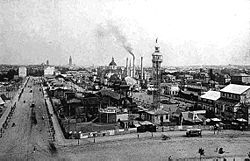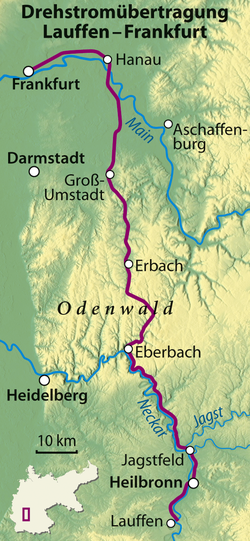
International Electro-Technical Exhibition - 1891
Encyclopedia



Three-phase electric power
Three-phase electric power is a common method of alternating-current electric power generation, transmission, and distribution. It is a type of polyphase system and is the most common method used by grids worldwide to transfer power. It is also used to power large motors and other heavy loads...
, which was generated 175 km away at Lauffen am Neckar. As a result of this successful field trial, three-phase current became established for electrical transmission networks throughout the world, thus ending the ongoing War of Currents
War of Currents
In the "War of Currents" era in the late 1880s, George Westinghouse and Thomas Edison became adversaries due to Edison's promotion of direct current for electric power distribution over alternating current advocated by several European companies and Westinghouse Electric based out of Pittsburgh,...
.
History
The “Elektrotechnische Gesellschaft“ (Electro-Technical Society) was founded in Frankfurt in 1881 with the aim of promoting electricity and, in particular, furthering research into its application for industry and technology. Three years later, some ten manufacturers of electrical equipment had set themselves up in the city. In around 1890, some of the enterprises were established which would later become major firms in Frankfurt: Hartmann & Braun, Staudt & Voigt (from 1891 Voigt & Haefner) and W Lahmeyer & Co (from 1893 Elektrizitäts-AG, previously W Lahmeyer & Co). And it was in Frankfurt that the “second industrial revolutionIndustrial Revolution
The Industrial Revolution was a period from the 18th to the 19th century where major changes in agriculture, manufacturing, mining, transportation, and technology had a profound effect on the social, economic and cultural conditions of the times...
” began to emerge – a revolution that would bring about fundamental changes similar to those created 100 years previously by the introduction of the steam engine
Steam engine
A steam engine is a heat engine that performs mechanical work using steam as its working fluid.Steam engines are external combustion engines, where the working fluid is separate from the combustion products. Non-combustion heat sources such as solar power, nuclear power or geothermal energy may be...
to the world of work. In 1891, the German electrical industry was ready to demonstrate its capabilities to the world at the International Electro-Technical Exhibition. A site was chosen – that of the former western stations
Frankfurt western stations
The Frankfurt western stations were a group of three stations on the western edge of the former city walls of Frankfurt am Main, Germany between the modern Willy-Brandt-Platz, then the location of Gallustor and Taunustor...
between the city and the new main station
Frankfurt (Main) Hauptbahnhof
is the central station for Frankfurt am Main. In terms of railway traffic, it is the busiest railway station in Germany. With about 350,000 passengers per day the station is the second most frequented railway station in Germany and one of the most frequented in Europe.- Proto-history :In the late...
, which had been completed in 1888.
Prompted by the Paris “Exposition Universelle
Exposition Universelle (1889)
The Exposition Universelle of 1889 was a World's Fair held in Paris, France from 6 May to 31 October 1889.It was held during the year of the 100th anniversary of the storming of the Bastille, an event traditionally considered as the symbol for the beginning of the French Revolution...
” (World Fair
World fair
World Fair can refer to:* Expo , a large public exhibition* This World Fair, an American rock band...
) of 1889, Leopold Sonnemann, publisher of the Frankfurter Zeitung
Frankfurter Zeitung
The Frankfurter Zeitung was a German language newspaper that appeared from 1856 to 1943. It emerged from a market letter that was published in Frankfurt...
newspaper, interested the Electro-Technical Society in the idea of an exhibition. The Society expressed an interest and started preparations in the same year. However, there was another consideration apart from the setting up of an international exhibition – Frankfurt had an urgent problem to solve. The construction of a central power station
Power station
A power station is an industrial facility for the generation of electric energy....
had been under discussion in the city’s political and technical committees since 1886. However, agreement had still to be reached over the type of current, and opinions were divided between direct current
Direct current
Direct current is the unidirectional flow of electric charge. Direct current is produced by such sources as batteries, thermocouples, solar cells, and commutator-type electric machines of the dynamo type. Direct current may flow in a conductor such as a wire, but can also flow through...
, alternating current
Alternating current
In alternating current the movement of electric charge periodically reverses direction. In direct current , the flow of electric charge is only in one direction....
and three-phase current. It fell to the exhibition to demonstrate a commercially viable method for the transmission of electricity. Three-phase current with a minimal loss of 25% would be transmitted at high voltage from Lauffen am Neckar to Frankfurt. This took centre stage at the exhibition and was evidenced in the large three-section entrance gate. The central section took the form of an arch bearing the inscription “Power Transmission Lauffen-Frankfurt 175 km.” Rectangular panels flanked the arch: the one to the right carrying the name of the “Allgemeine Electricitätsgesellschaft“
AEG
Allgemeine Elektricitäts-Gesellschaft was a German producer of electrical equipment founded in 1883 by Emil Rathenau....
("AEG" - General Electricity Company), which had been founded in 1887; the left-hand panel displayed the name of the “Maschinenfabrik Oerlikon” (Oerlikon Engineering Works). The entire entrance was illuminated with 1000 light bulbs and an electrically powered waterfall provided a further attraction. With 1,200,000 visitors from all over the world, the exhibition was an out-and-out success. The cost of a one-day entry ticket for an adult amounted to a considerable 15 marks
German gold mark
The Goldmark was the currency used in the German Empire from 1873 to 1914.-History:Before unification, the different German states issued a variety of different currencies, though most were linked to the Vereinsthaler, a silver coin containing 16⅔ grams of pure silver...
.
As far as Germany was concerned, the International Electro-Technical Exhibition settled once and for all the question of the most economical means of transmitting electrical energy
War of Currents
In the "War of Currents" era in the late 1880s, George Westinghouse and Thomas Edison became adversaries due to Edison's promotion of direct current for electric power distribution over alternating current advocated by several European companies and Westinghouse Electric based out of Pittsburgh,...
. When the exhibition closed, the power station
Power station
A power station is an industrial facility for the generation of electric energy....
at Lauffen continued in operation – providing electricity for the administrative capital, Heilbronn
Heilbronn
Heilbronn is a city in northern Baden-Württemberg, Germany. It is completely surrounded by Heilbronn County and with approximately 123.000 residents, it is the sixth-largest city in the state....
, thus making it the first place to be equipped with a power supply using three-phase AC. The name of the local power company (ZEAG) bears testimony to this event. The Frankfurt city council constructed its own power station
Power station
A power station is an industrial facility for the generation of electric energy....
near the harbour; yet another was built by a private company in the suburb of Bockenheim.
Equipment
A hydraulic turbine at Lauffen powered a three-phase alternator with a revolving field. The alternator revolved at 150 revolutions per minute, and had a rotating field magnet with 32 poles. It was rated at 300 HP and had a terminal voltage of 55 volts. The frequencyUtility frequency
The utility frequency, line frequency or mains frequency is the frequency at which alternating current is transmitted from a power plant to the end-user. In most parts of the world this is 50 Hz, although in the Americas it is typically 60 Hz...
of the current was 40 Hz. Power from the alternator was stepped up to 8000 volts for transmission by oil-insulated transformer
Transformer
A transformer is a device that transfers electrical energy from one circuit to another through inductively coupled conductors—the transformer's coils. A varying current in the first or primary winding creates a varying magnetic flux in the transformer's core and thus a varying magnetic field...
s. Later tests were carried out with transmission voltage up to 25,000 volts (between phases).
The transmission line was erected with the assistance of the German Post Office and used about 60 tons of copper wire, 4 mm in diameter. At the exhibition, the voltage was stepped down by further oil-filled transformers and connected to motors and a motor-generator system for lamps.
Overall efficiency from turbine to load was an average of 75%, which resolved many doubts of the practicality of long-distance electric power transmission.
External links
- Sabine Hock: Mehr Licht für Frankfurt, Oskar von Miller brachte Frankfurt auf den Weg zur Elektrifizierung, Online-Version eines Artikels für den Wochendienst Nr. 16 vom 26.04.2005, hg. v. Presse- und Informationsamt der Stadt Frankfurt am Main, auch veröffentlicht im Newsletter Geschichte des Geschichtsmagazins DAMALS, Nachricht vom 30.04.2005
- FITG-Journal, September 2007, Seiten 10-12
This article is based on a translation of the article about the Internationale Elektrotechnische Ausstellung 1891 which appears in the German Wikipedia.

